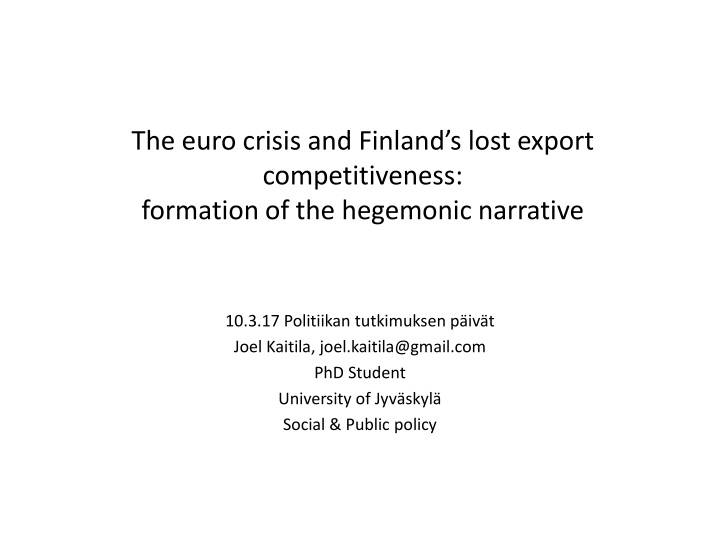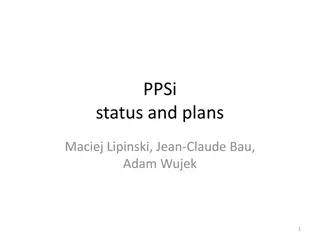
Finland's Export Competitiveness Crisis: Unpacking the Hegemonic Narrative
Explore how Finland's post-crisis performance is framed by a competitiveness gap, analyzing the consensus on wage moderation and labor reforms. Discover how expert opinions shape this narrative, with key debates surrounding wage levels, ULCs, and demand shocks remaining largely unchallenged.
Download Presentation

Please find below an Image/Link to download the presentation.
The content on the website is provided AS IS for your information and personal use only. It may not be sold, licensed, or shared on other websites without obtaining consent from the author. If you encounter any issues during the download, it is possible that the publisher has removed the file from their server.
You are allowed to download the files provided on this website for personal or commercial use, subject to the condition that they are used lawfully. All files are the property of their respective owners.
The content on the website is provided AS IS for your information and personal use only. It may not be sold, licensed, or shared on other websites without obtaining consent from the author.
E N D
Presentation Transcript
The euro crisis and Finlands lost export competitiveness: formation of the hegemonic narrative 10.3.17 Politiikan tutkimuksen p iv t Joel Kaitila, joel.kaitila@gmail.com PhD Student University of Jyv skyl Social & Public policy
Finlands competitiveness gap Recently, Finnish economic and social policy has been framed by the idea that a competitiveness gap explains its poor post-crisis performance Finland s export competitiveness measured by unit labour costs deteriorated in the aftermath of the 2008 financial crisis In a nutshell, ULCs measure labour costs relative to productivity deterioration can be driven by wage growth and/or productivity decline There is a tripartite consensus about the cause & cure of the problem between the Gov t, SAK and EK: 1) excessive wage growth has undermined Finland s competitiveness by 10-15 percent relative to key opponents 2) Fixing the problem requires a permanent policy of extreme wage moderation and labour market reforms ( TyKa & KiKy ) The implication of these policies is that national income will be distributed from wages to profits
How did the consensus view emerge? The consensus view of the diagnosis and adequate treatment of Finland s competitiveness gap emerged ca. 2013 In this study, two key planks of the consensus view are identified and analysed: 1) In the arena of expert debate and public opinion, the excessive wages argument won over 2) Moreover, consensus view largely unchallenged by the labour movement - especially the SAK, which has adopted it Theoretical framework: competition state literature & study of policy ideas
Framing the problem: expert opinion The first plank fits well into the competition state literature (e.g. Kantola & Kananen 2013; Heiskala ym. 2006) Experts framed the issue and were met with seemingly little opposition; narrative then picked up by key politicians, commentators, journalists However, e.g. Kajanoja (2013; 2015) and Sauramo (2013; 2015) have debated the issue academically: Are Finnish wage levels higher than its competitors ? Have Finnish collective bargaining outcomes in 2008-9 been excessive relative to its competitors? Are Finnish ULCs 10-15% higher than its competitors ? Was the ULC deterioration since 2007 mainly driven by a supply side shock (excessive wage increases) or a demand shock (GDP and productivity collapse)? Can Finland s export capacity trends be captured by cost factors what about Nokia s failure and forestry s decline? Sauramo s counter arguments are sound but barely utilised to challenge the consensus view by the labour movement
Wage moderation and ordoliberalism A long term shift in SAK s policy priorities toward an ordoliberal orientation might explain its accommodation to permanent wage moderation (e.g. Sauramo 2016) Ordoliberalism (e.g. Bonefeld 2012): how to defend liberal market economies facing pressures from international competition and societal mass movements? 1) macroeconomics of low inflation causes growth & 2) ethics of personal responsibility as a means of non-socialist legitimation EMU: low inflation & wage moderation as a policy goals austerity & export led growth How have SAK s priorities & behaviour changed in the EMU years? In the history of Finnish incomes policy, SAK targeted a stable labour share of national income (wages & productivity grow together) However, since EMU membership the priority has shifted towards low inflation via wage moderation (WS 70% 60% during 1990-2007) Implicit acceptance: wages are a cost 1st and a demand source 2nd SAK s accommodation to TyKA and KiKy continues a longer trend





















